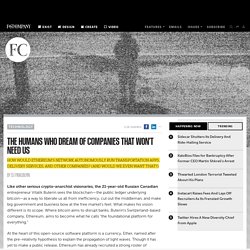

Forbes Welcome. The Humans Who Dream Of Companies That Won't Need Us. Like other serious crypto-anarchist visionaries, the 21-year-old Russian Canadian entrepreneur Vitalik Buterin sees the blockchain—the public ledger underlying bitcoin—as a way to liberate us all from inefficiency, cut out the middleman, and make big government and business bow at the free market's feet.

What makes his vision different is its scope. Where bitcoin aims to disrupt banks, Buterin's Switzerland-based company, Ethereum, aims to become what he calls "the foundational platform for everything. " Le blog de Thomas Piketty. Partager cet article.

Capitalism as socialism: defence of socialism in the socialist calculation of debate revisited. Paresh Chattopadhyay's contribution to the ongoing debates with state socialists on the allocation of resources in society, with specific reference to the Lange-Lerner model of socialism.

The wealth of nations. Why Information Grows: the Evolution of Order, from Atoms to EconomiesCésar Hidalgo 2015 Allen Lane/Basic Books £20.00/$26.99hb 256pp Why are some nations wealthier than others?

What, precisely, does it even mean for a nation to be wealthy? And why, as a matter of practical and political importance, do some nations become wealthier more quickly than others? If we ask why a crystal grows in solution, or study how a bacterial colony grows in a sugar medium, it's clear that the answers come down to physics – to matters of entropy and order, of information and organization. Yet such concepts, oddly enough, rarely play a role in economic analysis. Traditionally, when judging the wealth of a nation, or assessing its growth potential, economists have looked to a handful of aggregate indicators – things like gross domestic product (GDP), total resources, levels of education and so on. Hidalgo's perspective on economic wealth is wildly fresh and creative. Nasa-funded study: industrial civilisation headed for 'irreversible collapse'? A new study partly-sponsored by Nasa's Goddard Space Flight Center has highlighted the prospect that global industrial civilisation could collapse in coming decades due to unsustainable resource exploitation and increasingly unequal wealth distribution.

Noting that warnings of 'collapse' are often seen to be fringe or controversial, the study attempts to make sense of compelling historical data showing that "the process of rise-and-collapse is actually a recurrent cycle found throughout history. " Cases of severe civilisational disruption due to "precipitous collapse - often lasting centuries - have been quite common. " The independent research project is based on a new cross-disciplinary 'Human And Nature DYnamical' (HANDY) model, led by applied mathematician Safa Motesharrei of the US National Science Foundation-supported National Socio-Environmental Synthesis Center, in association with a team of natural and social scientists. Nasa-funded study: industrial civilisation headed for 'irreversible collapse'?
The value of banking according to Mark Carney and Alan Greenspan. Listening_to_Sharing_Economy_Initiatives.pdf. Tactivism. Vinay Gupta's Work. Re.silience.com - Vinay Gupta. Resilience Maps - Simple Critical Infrastructure Maps. Here are the five most over-hyped technologies of 2015, according to Gartner. Research firm Gartner has long promoted an analytical concept called the “hype cycle.”

Basically, the notion is that in the world of technology, people tend to get over-excited about new thingies, and then are disappointed when the new thingies don’t change the world in the blink of an eye. But after that, some of the thingies do actually change the world, given the right evolution and path and some patience. This is where things actually get interesting, if you don’t give up on them. From VentureBeat Your customers are hitting your platform from several different devices — are you prepared? In other words, it’s the basic lesson that Silicon Valley refuses to learn. Anyhoo, Gartner has released its latest hype cycle report this week. In any case, here are the five at the top of the “peak of inflated expectations” (aka, totally over-hyped): 1. 2. 3. 4. 5.
Gartner, Inc. Powered by VBProfiles. How To Convert a Business into a Worker-owned Cooperative. Cooperatives represent a growing segment of the economy with an estimated 30,000 enterprises and 100 million members in the U.S. alone.

A great way to bring democracy into the workplace, coops can be built from scratch, but they can also be created by converting existing businesses into worker-owned cooperatives. For retiring business owners as well as entrepreneurs, selling a business to employees is a way to strengthen the business while getting a return on investment. Melissa Hoover, executive director of the Democracy at Work Institute (DAWI), says that coop conversions are one of the most promising sources of new cooperatives as they already have customers, assets and employees, which makes it less risky than a startup. She also notes that those coops created from conversions are among the most passionate members of the U.S.
Spr-inequality-sdn-chart-1rev.jpg (JPEG Image, 960 × 720 pixels)